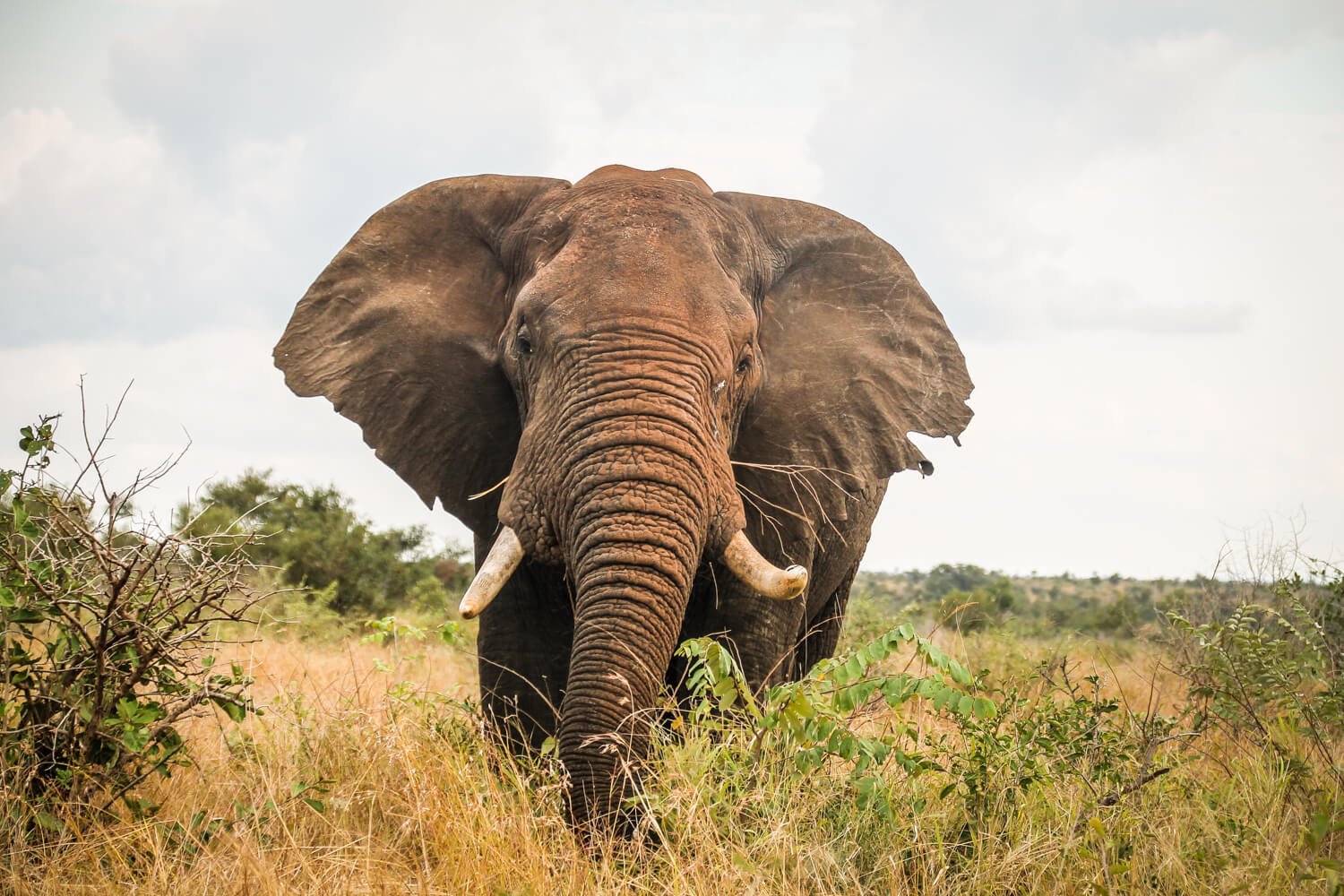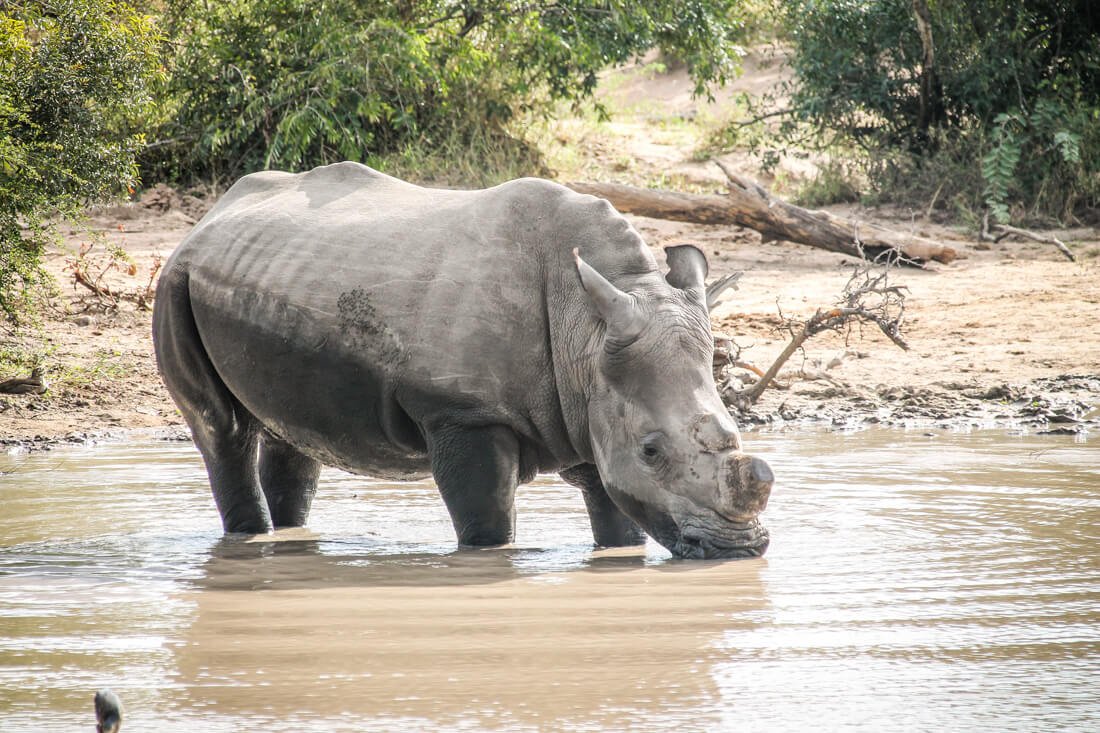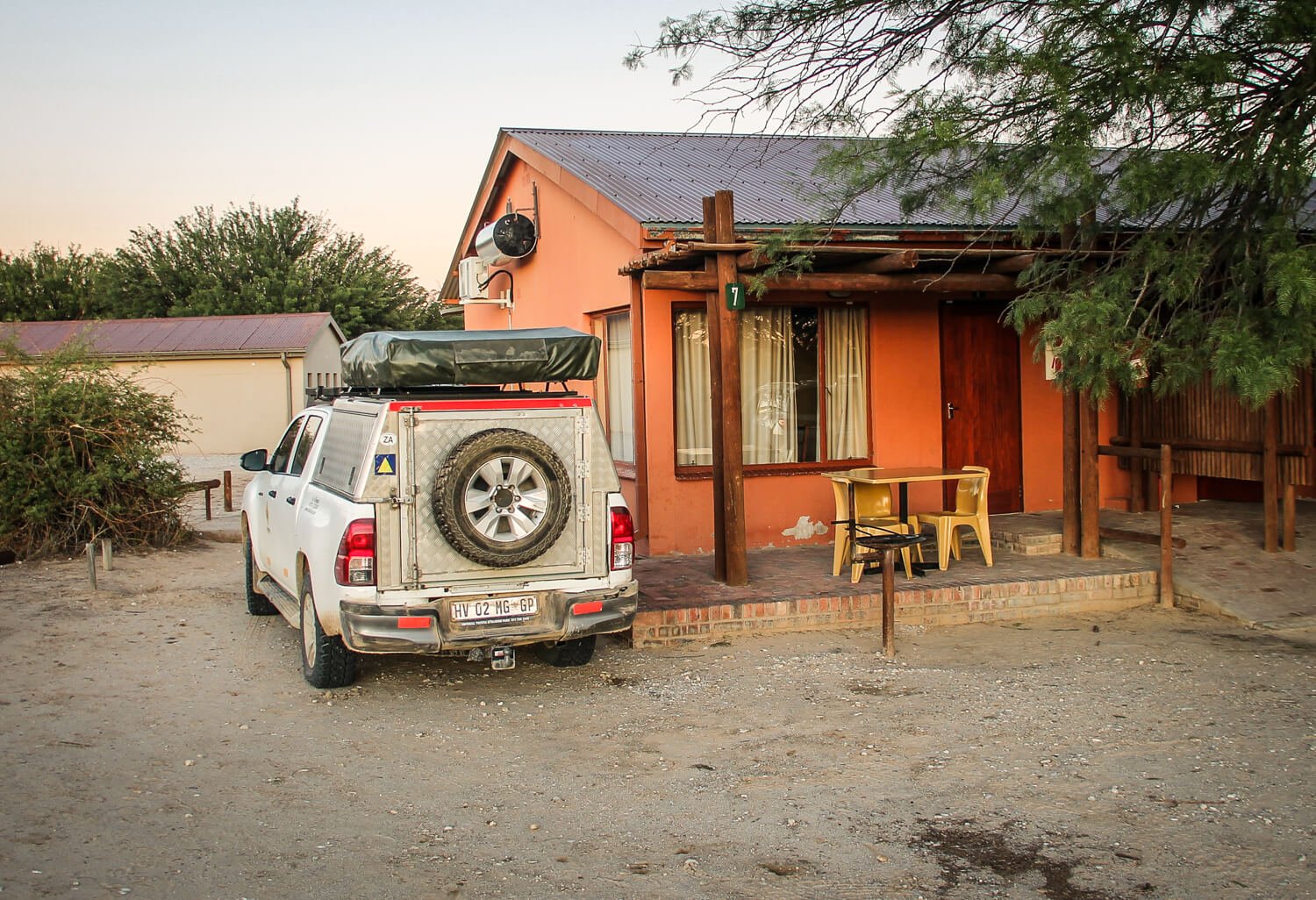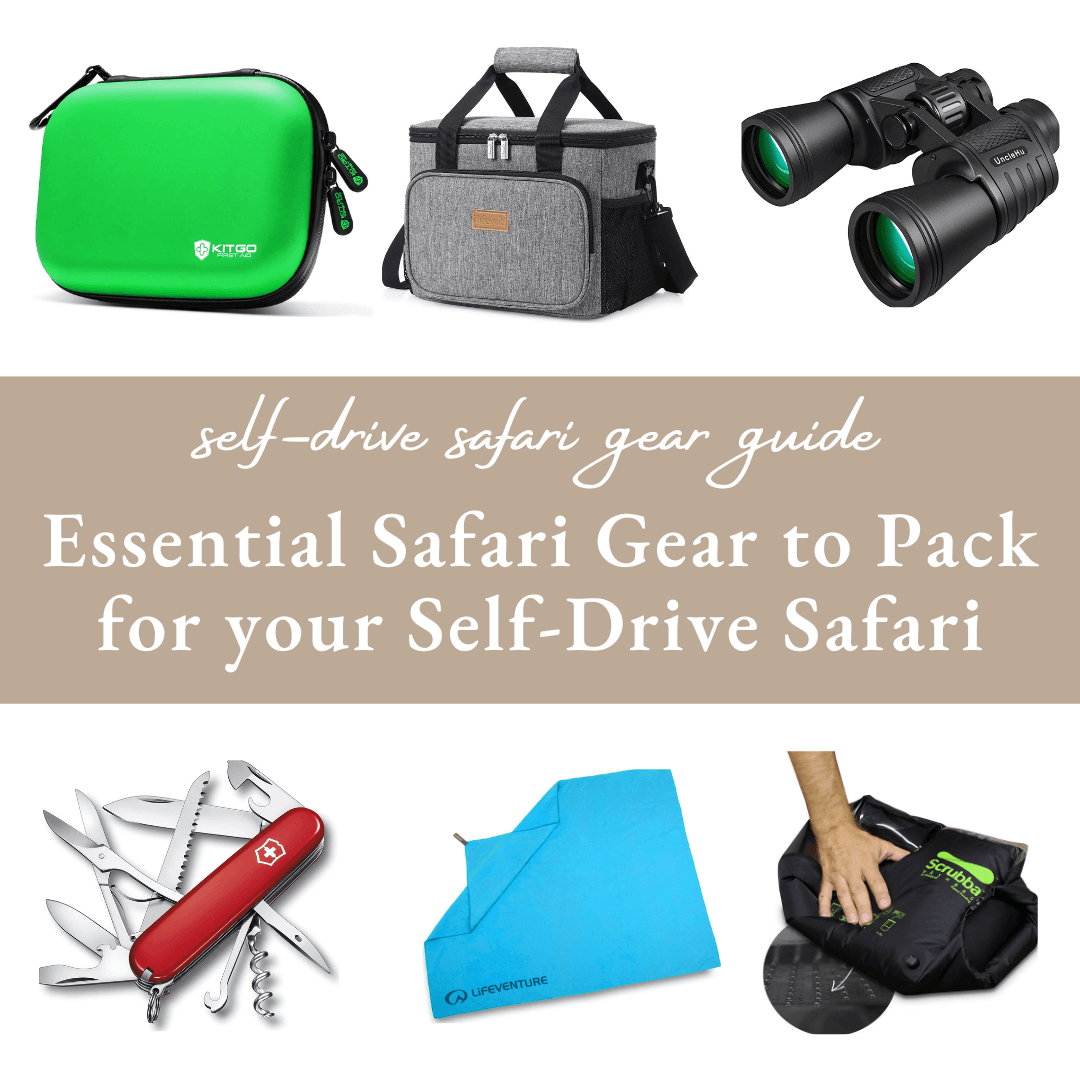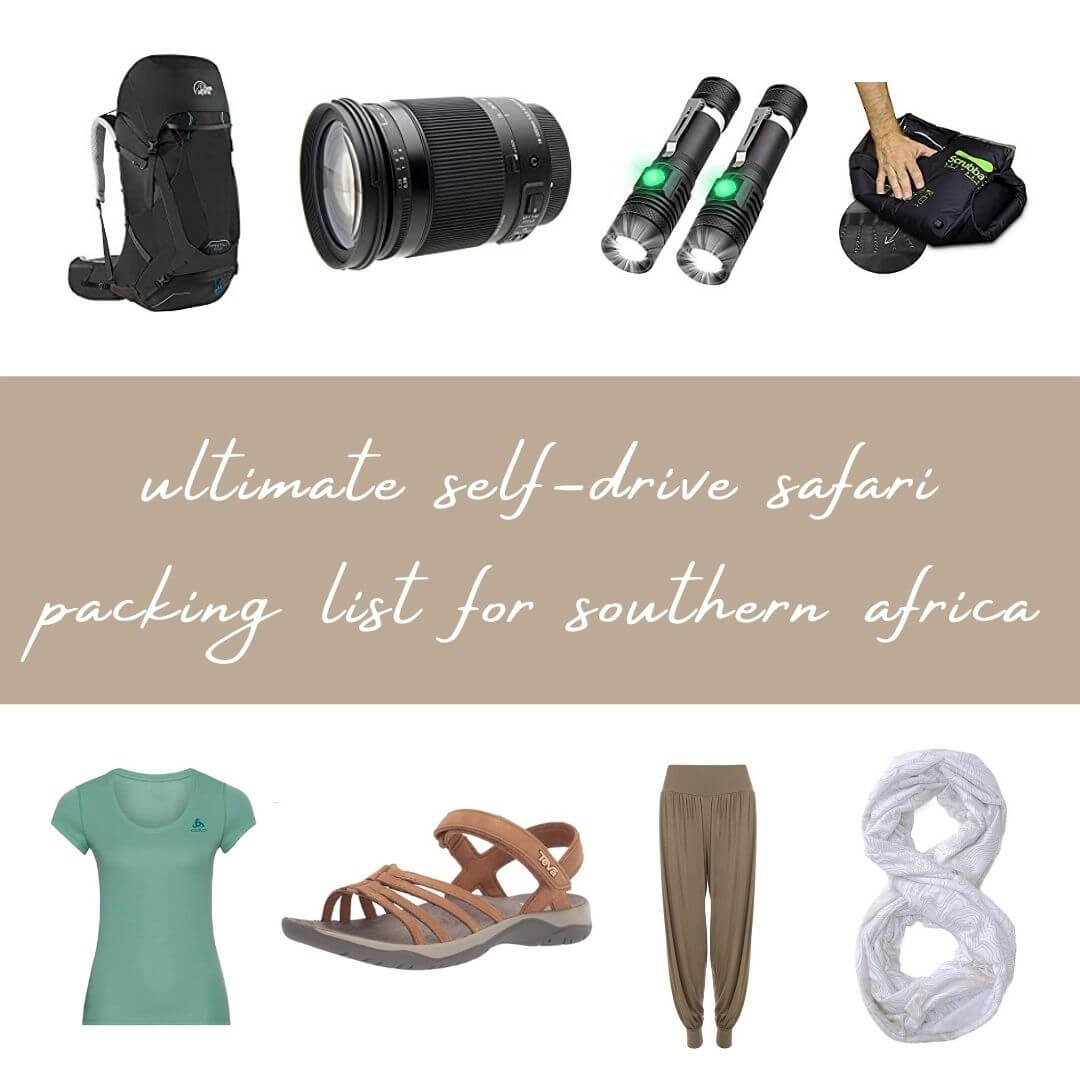Ultimate packing list self-drive safari in Southern Africa
Just to let you know… This post (probably) contains affiliate links, including Amazon Associates links, and we may receive a small commission if you click one. This is at no extra cost to you and allows us to keep our blog running.
My first safari was part of a 6-month semester abroad and I had to suffice with the clothes I was able to pack into a 65L backpack for a 6-month stay in South Africa. So there had not been much consideration into what would work on safari but the one thing that saved me was layering so that I would be warm enough at 5 am when it was still cold and not too warm during the heat of the day.
Over the years it has become a sport to reduce the weight off our backpacks compared to the previous time. And I think we have established quite a thorough packing list for our self-drive camping safaris without breaking your back or the bank.
So in this post, we’ll share with you what we take on our safari’s.
Luggage & Travel bags for your self-drive safari
Because whether you’re on a self-drive safari, flying to remote destinations or have to put your bag in a locker in an overland truck there generally is not a lot of space so you need to have a soft bag (so no suitcases) that can fit into small spaces. So a soft duffel bag or backpack is great for going on safari and I think which one you pick has more to do with personal preference.
While you don’t tend to walk around a lot with your bag on safari, we always travel with our backpacks. It’s large enough to fit everything in, even the things we need to bring when camping, it makes walking around a busy airport much easier and quicker (the one time I took a suitcase on a trip it gave me blisters from constantly picking it up and pulling it around) and it’s easier to not pack too much.
Backpack: We already have had our Low Alpine backpacks for over 10 years so the same one does not exist anymore but this 65L backpack from Low Alpine comes quite close. The top is extendable so you can increase the volume by 15 litres. And while 80 litres is a lot I’ve always found it easy to carry this backback as the straps are really supportive. It has several straps on the side to make the bag smaller. It also has 2 compartments, one is large and accessible from the opening at the top, one at the bottom which has a separate zipper on the outside to access just that compartment. This is here I always have the clothes I need most often (like socks and underwear) separated by packing cubes.
Flight bag: We love to travel with our backpacks but there is a downside to it because your stuff is not as protected as with the locks on your suitcase. So you need a flight bag to protect it and make sure nothing can be taken from your pack. In the past we had a flight bag that had a cord at the top to close it but after these were damaged in an attempt to get our car out while we were stuck in soft sand (which was quite a genius idea from Sam) we got these from backpack locker. You can easily get your pack in and zip it up. Then you can you use a lock to close the zips. It has shoulder and side handles to pick it up. And it hardly takes any space when you’re not using it but often put our pack in them while on safari to keep out all the dust.
Daypack: Next to your backpack you will need a daypack. Just like with our backpack we already have our Low Alpine daypack for over 10 years. By now it’s quite stained but still working like it’s supposed to but the exact same ones do not exist anymore but this 25L daypack comes quite close. It has a main compartment with its own zipper, a smaller compartment in front with its own zipper with an internal pocket and a hook, and side mesh pockets.
Luggage organisers: We never travel without these luggage organisers. Just stack them in your backpack and you never have to search through your whole bag again.
Photography Gear for your self-drive safari
I have loved photography for as long as I can remember so when I had the chance to go on my first safari I grabbed it with both hands. But I was also a 20 year old student and my budget, next to paying for 6 months in South Africa, for a camera was limited. I started out with a Canon PowerShot (compact camera) on that trip but upgraded to a Canon EOS 1100D when I could afford it.
We have seen huge lenses come out of car windows in Etosha that were mounted on a tripod and recently saw a picture of a car that had a metal frame mounted on the outside to keep the camera level. I don’t we will go that far as I like to be able to travel light and don’t want to bring a separate backpack for my camera gear.
I still use the Canon EOS 1100D but bought a larger lens for our Namibia trip (300mm) and probably will go for a slightly larger one for our next trip as the quality of photo’s has massive improved since getting the larger lens, but this one should still fit in my current camera bag.
So while we would advise a larger lens than the standard 15-55mm lens you often get with a camera, with photography gear it’s really about the budget that you have. And it doesn’t mean you can’t have fun with a smaller camera.
Camera: We’ve had a Canon EOS 1100D for a while and this is an entry level DSLR camera. But this model is not in production anymore. The Canon EOS 1200D Digital SLR Camera is the replacement with a better photo and video resolution and a EF-S 18-55 mm f/3.5-5.6 III Lens and some renewed/refurbished models are still available.
But if you want to go for a new camera you can start with the Canon EOS 2000D DSLR Camera, which is the cheapest model. If you have a larger budget but want to stay under £1000 the Canon EOS 850D with an EF-S 18-55mm f/4-5.6 could also be an option. But if you want a larger lens your budget needs to be +£1000.Camera Lens: We have an 18-300mm F3.5-6.3 Macro lens that already works much better than the standard 15-55mm lenses you often get with a camera but would love to have an even bigger one of 400mm. I was happy with the lens that came with the Canon but when I got into wildlife photography a bit more, I felt a bigger lens was needed for our safari trips. And we went for the Sigma with a 18-300mm F3.5-6.3 Macro lens.
Camera bag: With the new lens we also needed a bigger camera bag and this Canon ES100 Bag is great. It’s still compact and can fit into our backpack, as we did not want a large separate backpack for it but still fits both lenses, adaptors, memory cards and cleaning equipment. We recently backed the Nest Backpack from Tropicfeel on kickstarter and they have a special camera cub that fit’s in this bag so looking forward to test this out.
SD card: You also need a backup SD card: You never want to run out of memory for al your great images. This SanDisk with 64GB is compatible with SDHC/SDXC and SDHC-I/SDXC-I devices. If you need more there is also a 256GB version.
Backing up your photo’s: This Gibot USB Type C Micro USB SD Card Reader has a standard USB 2.0 plug (type A) and micro USB plug (type B) and USB C plug (Type C) so you will be able to backup your images.
Cleaning kit: You want to keep your camera and lenses clean and this Amazon Basics Cleaning Kit for DSLR Cameras is ideal because it has lens tissues, brushes, cleaning pas, air blower and cleaning cloths.
UV filter: This Amazon Basics UV Protection Filter - 72 mm is for UV protection of your lens and reduces ultraviolet light, helps eliminate bluish cast in images and protects your lens from dust, dirt, and scratches.
Tripot: We bought this iGadgitz U4857 (PT310) Mini Lightweight Table Top Stand Tripod which is also a stabiliser grip for our Namibia trip because we had booked a couple of hours in a hide and wanted to make sure the camera was steady.
Camera protection: Another purchase for our Namibia trip. This is a Navitech protector against sand and water. It’s not easy to get your camera in but we wanted to make sure that a windy day in the Sossusvlei did not break our camera.
Technology for your self-drive safari
We don’t bring too much technology (I think) with us but be sure to check what plugs you need to bring and other technology to have enough power as you don’t always have electricity in camps or only till a certain time of the day. Besides this we bring some tech for evening and airplane entertainment.
Adapter: If you’re traveling to South Africa or Namibia you need a special plug as they are not part of universal plugs (at least, we have never found one). If you have a lot of devices that need to be charged through USB it might be worth also taking a USB wall.
Power bank: We like to take a power bank next to our chargers as not all campsites have electricity. This Anker Power Bank is only 495g and has 3 USB and 2 micro-USB ports.
Apple connector: Don’t think this is an official name but if you have an iPhone, Ipad and a Macbook you have different cables and know how annoying it can be that you have to bring different cables. With this UGREEN USB C to Lightning Cable, you can connect your iPhone with the other devices.
Other devices: You don’t need to bring and Ipad or Macbook for your safari but we tend to bring both. The Ipad is for entertainment in the plane and for evenings. And we use the Macbook to backup out photographs and because I run my own business. I always try not to work on holiday (not having wifi on safari definitely helps with this) but like to have it with me for the moments we do have wifi and there is something with one of my client projects. But if you do bring them an Ipad protector like this felt sleeve to protect your devices is essential. It’s large enough to fit a 13-inch MacBook Pro and an 12.9-inch iPad Pro and has an extra storage pouch for your cables
E-reader: As much as I love real paper books, while traveling a Kobo is ideal.
Accessories for your self-drive safari
I’ve tried to split this in general accessories that we think you need on any safari and equipment that you only need when you’re going camping in the section underneath.
Binoculars: because the animals don’t just wander along the roads and there is a large chance you need binoculars to make sure you’re seeing an elephant, rhino or a grey rock in the distance. If you want to keep the costs down this UncleHu is a great option. It has a 26mm eye lens and 50mm objective lens diameter and it has a special coat on the lenses for light reflection and and to minimise the distortion.
Pocket knife: We always take a small Swiss army knife with us. Mostly used to open a bottle of wine or beer but can be used for other things as well ;)
Torch: When staying in camps, no matter if you camp or not, you always want to have a torch with you for walking in the camps at night. These iToncs torches are great because they are USB rechargeable. So no need for spare batteries and they are only 290g. But if you’re staying at a camp alongside a dry riverbed a large torch is better to spot animals. In Kgalagadi Transfrontier Park we have seen others with these heavy duty lanterns.
Lantern: We also use a solar-powered camping lantern for on our table. This solar-powered lantern comes in great on the dark nights by your tent for when you’re cooking or trying to plan your route for the next day. The fold up easily so they don’t take up a lot of space and you can just pop them on the dash of your car to charge while you’re driving around.
Quick dry towels: It’s not the best experience but we’re all for packing light so lightweight and quick-drying towels are a must. These towels are lightweight, fold up very small, absorb water well and dry quickly. Just pin them between car doors & let the sun dry them in no time.
Travel sheets: This is a personal preference but we use travel sheets to line the rented sleeping bags with. It can also act as a sheet to lie under when it’s too warm for a sleeping bag.
Laundry: Don’t expect to find a lot of facilities to was your clothes while on safari. So you will need to bring some laundry detergent to washing your clothes. We used to bring this biodegradable laundry wash to wash in a basin but we have this laundry bag on our wish list that will make washing much easier. If you wash your clothes you also need to dry them and this clothesline is ideal because you don’t need pegs and can easily be hooked onto trees.
Mini bottles for personal toiletries: We always try to keep our bags as light as possible and don’t want to take full size bottles. So this mini bottle set takes care of that and you can still bring your own products
Neck Pillow: you have these great fluffy neck pillow for on the plane but I don’t like having to walk around with them or adding so much volume to my pack so we use these inflatable neck pillows.
Camping Equipment for your self-drive safari
We’ll break up the list in 2 parts; the first is the gear that is included with your car rental and the second part is about what you still need to bring.
As you can see from the below list the equipment you get with your car is quite extensive but when looking to rent your 4WD with camping equipment make sure to check what is included in the price as not every car rental is including the same things. One of these things is a fridge. Even if you’re not camping a fridge can be a great addition because shops in National Parks are not created equal. While the shops in Kruger National Park are well stocked, the same can not be said from the shops in Etosha or Kgalagadi so you want to stock up before entering the park. But it will also help you on your drives to keep your lunch, snacks and drinks cool (just be sure you only get out of your car in designated area’s).
When you do require a fridge, make sure to also have a second battery. This is so that the fridge is not impacting your main battery immediately and you can keep it on also when not driving. You will also get an electricity cable that you can plug in your car when you do have it on your campsite (as not all campsites have electricity) so that the fridge can run on that.
24 Piece Cutlery Bag
Cooking Pots
Frying Pan
Kettle
Plates
Bowls
Glasses
Wine goblets
Mugs
Light
Tablecloth
Breadboard
Can opener
Corkscrew
Barbeque Tongs
Barbeque Grid
Camping Equipment
Rooftop Tent
Rain cover for the tent
Tent Pegs
Gas Bottle
Cooker Top
Chairs
Table
Camping Equipment cont
Dustpan & brush
Fire extinguisher
Water basin
Pillows
Sleeping bags
Towels
Pillows
Sleeping bags
Vehicle
Second Battery
2x Spare Tyre
Tow Rope
Jumper Cables
Tools for Tyre change
Compressor
Fuses
Watertank 45l
Spade
Fridge
WHAT DO YOU NEED TO BRING?
A brush: this one might seem odd but if you’ve driven on gravel roads you know how dusty everything gets. A brush like this is great to clean your car, bags and shoes.
Dishwashing: Kitchen towels, scrub sponge and dishwashing liquid
Cooking: We like to bring some seasoning for cooking instead of having to buy in the supermarket and then not use it all. We use the small jars from this bottle set to bring salt, pepper & dishwashing liquid.
A very important one: instant coffee. Not ideal but if there’s nothing else or if the camp shops are not open yet it will definitely help with the early mornings.
Zip-lock bags: We bring them to preserve our food but they also double as dry bags or to keep dirty laundry from the rest of the clothes.
Buy or bring toilet paper; just in case
First aid kit for your self-drive safari
You can be quite far away from a doctor or a hospital so we like to be prepared and have a fully stocked first aid kit with:
Paracetamol
Antiseptic wound wash to protect against infection when you have cuts
Triangular bandage
Alcohol-free cleansing wipes
Bandages and plasters
Band-aids
Diarrhoea relief and electrolyte powder
Pills against travel sickness
Echinaforce tablets to prevent colds (which happens quite often when coming from colder weather and the cold of the air in a plane)
For the same reason, we also bring tissues and strepsils.
Tweezer
Latex gloves
Scissors
Next to the first aid kit, we pack insect repellent and insect bite relief pens to treat the bites. As well as antibacterial hand gel and biodegradable wet/baby wipes. These last ones might sound strange and has only been an addition to our packing list since Namibia but it is great to clean dirty hands before eating, cleaning the table before preparing food or just wipe your face or arms if you’re covered in dust and there is no water or you have to wait to be able to shower.
And off course sunscreen, after-sun and body lotion. Even tough you’re in the car most of the time, you often have the windows open and the sun is so strong that you’ll burn easily and your skin will dry out quickly. These are also the only toiletries that we bring the full bottles because you will use a lot of it, and they are really expensive to buy in the supermarket or one of the camp shops.
Clothing & Shoes for your self-drive safari
You just have to type safari packing list into Pinterest to see collages of the clothes you should bring on safari: skirts, dresses, small handbags, huge sun hats and heels. This might be great when you’re on a luxury safari and all you have to do is walk to the safari truck, but it’s a while different thing when you’re on a self-drive camping safari.
We are all about practical and comfortable and you can see mostly see that from the clothes that we bring.
Pants
1x pair of Jeans: Which we tend to wear on the plane. We often travel in November/December which is winter here in Scotland but we generally don’t have to wear them on our trip.
1x pair of linen pants: For when it’s a bit colder or when we need long pants for things like a walking safari
2x pair of shorts: Don’t think I need to explain these ;)
Harem pants: I’m not the biggest fan of shorts so I always bring a pair of harem pants and find these ideal for in the car as they’re light, airy and give you some space to move around in.
shirts
Short sleeves: We often bring a mix of cotton shirts and some fast drying shirts. We love the t-shirts and tank tops from Odlo like this Odlo - F-Dry shirt. These shirts are great for a self-drive safari because they’re lightweight, keep you cool and dry fast.
Long Sleeves: For when the temperature starts to drop we bring 1 or 2 cotton long sleeve shirts
Fleece or Hoody: But for the really cold mornings or during evening or night drives we have a hoody or fleece like this one from Odlo. Next to a hoody or fleece I always bring a body warmer. I love these for one the plane as an extra layer in case it is cold or when it’s warm I pop it behind my back for some extra support.
If we’re on a road trip where we also travel outside of the national parks we also bring a nice/dressy shirt.
JACKET
Light windbreaker: We don’t use it often but you don’t want to leave home without a light jacket in case it rains.
OTHER
Scarf/Buff: I use a scarf for in the car as I often have an issue with the seat belt scratching my neck if I’m wearing a t-shirt. For our next trip I would like to get one of these travel scarfs as they have a hidden pocket that you can use to store a small wallet or your passport. And for those days that it’s windy and the sand is blowing it’s nice to have a Buff.
Sleepwear: This can be a tricky one as there are days that it’s so warm that you have all your windows open and want to sleep in the thinnest sleepwear possible. Then there are other days that it’s raining at night or there is a lot of wind and it cools down quite a bit. Each night I pack a separate bag that we bring into the tent which has our clothes and toiletries in there for the next day. But it also has some socks, a hoody and sweatpants in case it gets cold during the night or for bathroom breaks.
Underwear: We bring a mix of cotton underwear and some fast drying ones. We love the ones from Odlo. Just like the t-shirts, these are lightweight, keep you cool and dry fast.
Swimwear: To cool down in the pool after a long warm day
Bra: This one is for the ladies but I would advice to bring some sturdy sports bra’s like these from Odlo because the roads can be bumpy.
SHOES
Walking Shoes: I’m on my second pair on Hanwag’s and Sam’s has Lowa Renegades. Just make sure you also bring a couple pairs of walking socks when you bring these shoes. Most or ours are from Bridgedale.
Sandals: I still have an older version sandal from Teva but have my eyes on these ones from Teva with leather straps. Sam also had a pair of Teva with leather straps
Flip Flops: to take with you to the shower
And there you have it...
... our take on an ultimate self-drive safari packing list. We hope you enjoyed it and if you have any questions just leave your comments below. And if you are planning your own self-drive safari let us know below where you are going
Want to know more about great self-drive safari locations and how to prepare for a self-drive safari? Keep on reading the following blogs:
Ultimate Guide for self-drive safari in Etosha National Park - Namibia
Ultimate guide for a Self-drive safari in Kgalagadi Transfrontier Park
If you don't want to miss any of our upcoming posts you can sign up below and you'll get them straight in your inbox.
If you're on Pinterest you can save this post for later.
you’ll also love
Leave a Reply
and if you enjoyed this blog, found it useful & think it could help others, use the icons below to share on social media and spread the love
















